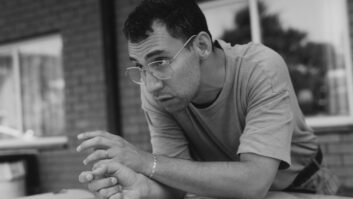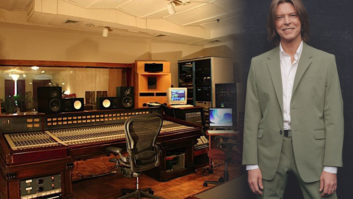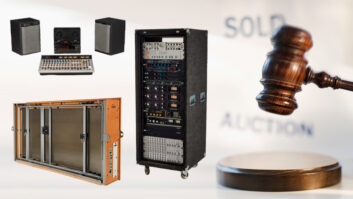
Craig Parker Adams not only tracked but also videotaped the session when Blasters frontman Phil Alvin shared lead vocals with his brother, former Blasters guitarist and songwriter Dave Alvin, for the first time. When the Alvins traded playful jabs on Dave’s song “What’s Up With Your Brother” (Eleven Eleven, 2011), it was not only the first time they sang on record together, it was also the first time they’d recorded anything together since Dave left the roots/rockabilly Blasters to begin his solo career in 1981.
“That was one to remember. It was the first time I met Phil, and I got a feeling right away of the brotherly thing they were known for,” Adams says diplomatically. “But that was before Phil died twice in Spain.”
Adams is referring to the near-fatal episode that Phil had on tour while suffering the after-effects of a dangerous MRSA infection. Both brothers have recounted the story of how Phil flatlined two times, and was miraculously revived. The elder Alvin lived to sing another day, and the event rendered meaningless any “brotherly things” that may have stood between them in the past.
After Phil recovered, the brothers went back to Adams’ studio, Winslow Ct. (Hollywood), where Dave has recorded eight of his past nine projects. They made the Big Bill Broonzy tribute album Common Ground with Dave’s touring band The Guilty Ones, and it was a meaningful way to honor the blues music that had inspired them to become musicians to begin with—to rediscover their common ground.
“It was a beautiful thing to see firsthand,” Adams recalls. “It was just the two of them and me a lot of the time, and much of what they were experiencing sort of went through me. They had decided that they were going to get along, and I saw no issues between them. What I saw was one brother, Dave, trying to help his older brother, Phil, reconnect to the music and heal. Dave never does things like this—he usually just lets me do my thing—but he took me aside and just said, ‘Whatever he wants, okay?’”

A tour and a Grammy nomination followed, and now, the brothers have recorded a follow-up. On their new album, Lost Time, the Alvins and The Guilty Ones cover more of their heroes, including James Brown, Big Joe Turner, Oscar Brown, Jr. and others. Engineer/producer/studio owner Adams again co-produced, recorded and mixed the group in Winslow Ct., which he has owned and operated for 18 years.
“This studio is actually considered to be one of the oldest sound recording studios in the world for film,” Adams says. “It was built by the Pacific Electric Company. When it looked like films were going to start having sound, the owner built this studio and it’s been here ever since, right next door to the Paramount Studios lot.”
The studio has mainly been used for TV and film post-production for 100 years.
“My tracking room is an old Foley room,” says Adams. “All the original Foley pits and surfaces are still there, and everywhere outside of the Foley area has its own piece of flooring. The different surfaces are not physically connected [to each other], so vibration doesn’t transfer through.”

These qualities are a great boon to Adams, who does a lot of live band recording. “It’s not a big room, but Dave likes it because when everybody plays, they’re all up against each other kind of in a circle. The amps are in the same room when I track. On Common Ground and Lost Time, everybody was in the same room except for Phil, who was in my vocal booth.
“Another reason it works is, there are six 7-feet-wide, floor-to-ceiling diffusors in the room, and 13- to 16-foot ceilings at an angle,” Adams says. “If you shot off a sound wave in the center of the room, it ends up reflecting and canceling itself out, so you get all these safe pockets in close proximity, so the bleed is minimal. You can have guitar amps cranking, and if I put a gobo in front of them, they do not bleed into the drum overheads.”
Of course, there were guitar amps cranking on these sessions: Dave Alvin’s Fender Vibroverb and Chris Miller’s Fender Deluxe. Adams’ approach to The Guilty Ones’ two-guitar attack is to mike one amp with a Shure 57 and the other with a Sennheiser 421. “Whichever guitarist has the brighter tonality will have the 421,” he says. “That ensures a nice separation of the tones, and it warms up the bite of the brighter instrument.”
Both guitar mics were run through Brent Averill API 312A mic pre’s, to Apogee AD16X converters, to Pro Tools HD 11. During tracking, Dave sang a scratch vocal because the songs include vocal duets and interplay. Phil sang live to a Neumann U 87, and Dave’s keeper vocals were overdubbed to the same U 87.

“Here’s how it goes down,” Adams says. “The band doesn’t know anything about the songs going in. Dave will have them sit in the lounge and he will play an acoustic, to show them the feel that he wants. They’ll absorb all that, and then they walk out into the room, and I start recording. It just starts showing up—sometimes immediately, and sometimes it’s several takes before they find it. But multiple takes are never because they’re trying to get anything really polished; it’s only because they’re trying to find it.”
Adams says that when he recorded Common Ground, Phil Alvin seemed barely to recognize his own voice coming through the NS10s, because he felt so changed. But critics and listeners hear the unmistakable beauty of what the Alvin brothers create together. These blues- and rock ’n’ roll-loving brothers don’t sing in magical sibling harmonies like the Everlys, but for 30 years fans missed the wonder of Phil Alvin’s mighty voice singing Dave Alvin’s songs, not to mention the younger Alvin’s deep skill and feel on guitar. The Alvins may have changed, but they’ve lost nothing.







